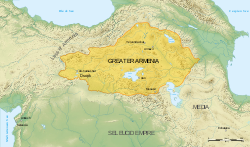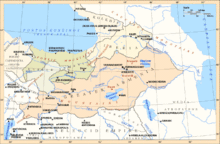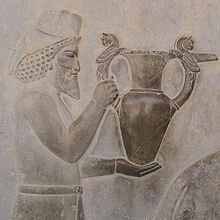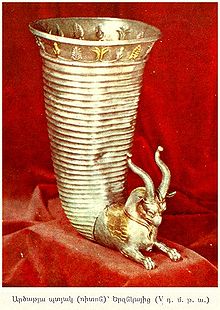- Satrapy of Armenia
-
This article is about the Satrapy of Armenia. For a list of other Armenian Kingdoms, see Kingdom of Armenia (disambiguation).
Satrapy of Armenia
Հայաստանի Սատրապ
Hayastani SatrapSatrapy, Kingdom ← 
6th c. BC–2nd c. BC  →
→
 →
→Territory of the Orontid Dynasty in 250 BC Capital Armavir,
YervandashatLanguage(s) Armenian,
possibly UrartianReligion Zoroastrianism Government Monarchy King Orontes I (first)
Hydarnes (last)Historical era Ancient - Established 6th c. BC - Disestablished 2nd c. BC Today part of  Armenia
Armenia
 Azerbaijan
Azerbaijan
 Georgia
Georgia
 Iran
Iran
 Turkey
TurkeyHistory of Armenia 
This article is part of a seriesPrehistory
2400 BC - 590 BCName of Armenia Hayk Hayasa-Azzi Nairi · Urartu Antiquity
591 BC - 428 ADOrontid Armenia Kingdom of Armenia Kingdom of Sophene Kingdom of Commagene Lesser Armenia Roman Armenia Dynasties: Orontid · Artaxiad · Arsacid Middle Ages
429 - 1375Marzpanate Period Byzantine Armenia Sassanid Armenia Arab conquest of Armenia Emirate of Armenia Bagratid Armenia Kingdom of Vaspurakan Armenian Kingdom of Cilicia Zakarid Armenia Dynasties: Bagratid · Rubenid · Artsruni Foreign Rule
1376 - 1918Persian · Ottoman · Russian Armenian Oblast Armenian national movement Hamidian massacres Armenian Genocide Contemporary
1918 - presentDemocratic Republic of Armenia Armenian Soviet Socialist Republic Nagorno-Karabakh War Republic of Armenia
Armenia Portal
The Satrapy of Armenia (Armenian: Հայաստանի Սատրապ Hayastani Satrap; Old Persian: Armina or Arminiya), also known as Orontid Armenia (Armenian: Երվանդունի Հայաստան Yervanduni Hayastan) after the ruling Orontid Dynasty, was one of the satrapies of the Achaemenid Empire in the 6th century BC, which later became an independent kingdom. Its capitals were Armavir and Yervandashat.
Contents
History
Origins
Shortly after the collapse of Urartu at the hand of the Medes and Scythians, the territory was conquered by the Achaemenid Empire and incorporated as satrapies of the land of "Armina" (in Old Persian; "Harminuya" in Elamite; "Urashtu" in Bablylonian).
Orontid Dynasty
Main article: Orontid DynastyThe Orontid Dynasty, or known by their native name, Yervanduni, was a hereditary Armenian dynasty and the rulers of the successor state to the Iron Age kingdom of Ararat.[1][2][3][4][5] Of probable Iranian origin,[6] members of the dynasty ruled Armenia intermittently during the period spanning the 6th to at least the 2nd century BC, first as client kings or satraps of the Median and Achaemenid empires who established an independent kingdom after the collapse of the Achaemenid empire, and later as kings of Sophene and Commagene who eventually succumbed to the Roman Empire.
The Orontids established their supremacy over Armenia around the time of the Scythian and Median invasion in the 6th century BC.[7] Its founder was Orontes I (Armenian: Երվանդ Ա. Yervand I). His son Tigranes Orontid united his forces with Cyrus the Great and killed Media's king. Moses of Chorene calls him "the wisest, most powerful and bravest of Armenian Kings." From 553 BC to 521 BC Armenia was Achaemenid Empire's ally, but during Darius I's reign, he decided to conquer Armenia. He sent an Armenian named Dâdarši to suffocate the revolt, later substituting him for the Persian Vaumisa who defeated the Armenians on May 20, 521 BC. Around the same time, another Armenian by the name of Arakha, son of Haldita, claimed to be the son of the last king of Babylon, Nabonidus, and renamed himself Nebuchadnezzar IV. His rebellion was short lived and was suppressed by Intaphrenes, Darius' bow carrier. After five raids Armenia resisted.
Greek cmomander and historian Xenophon provided important information on the Orontid Armenia. After Battle of Gaugamela (331 BC) Orontes III restored independence in Armenia. But in 201 BC, Armenia was conquered by Artashes, an Armenian commander in Seleucid Empire, who was also a descendant of the Orontid dynasty. The last Orontid king Orontes IV was killed, but the Orontids continued to rule in Sophene and Commagene until the 1st century BC. In two inscriptions of king Antiochus I of Commagene on his monument at Nemrut an Orontes, called Aroandes (son of Artasouras and husband of Artaxerxes's daughter Rhodogoune), is reckoned, among others, as an ancestor of the Orontids ruling over Commagene, who traced back their family to Darius I.
Armenia as Xenophon saw it
Greek mercenary soldiers, ten thousand in number, who had been aiding the younger Cyrus of Persia against his brother Artaxerxes, returned home in 401 BC, after the defeat and death of Cyrus at Cunaxa. On their way back, they passed through Armenia, and the Anabasis (going up), written by Xenophon, their leader, contains some valuable information about that country. Their precise itinerary has not been definitely traced, but according to the generally accepted theory, they crossed the Centrites (Kentrides) River, the modern Bohtan‑Su, north of Til, reached the Teleboas River, the modern Kara‑Su, in the plain of Mush, and then the Euphrates near Manazkert, fording it where it was only knee-deep. Thence they marched to Olti, the country of the Taochci (the Armenian province of Taiq), south of Kars. From the "great rich and populous city" of Cumnias, in the Scythian country (the more modern Cumri, still later Alexandropol and now Leninakan), they proceeded through the area of Zarishat and south of Ardahan, and finally through the mountains of the Macroni and Kolchi tribes to the Black Sea port of Trebizond.
Armenia is described by Xenophon as a vast and rich country, with Orondas(Orontes) (Erouand, Ervanduni) ruling as satrap and Tiribaz as uparkos or vice-governor. In Xenophon's time the Armens had not yet occupied the plain of Ararat, which was then inhabited by Saspeirs, Alarodians (Urarteans) and the oldest native tribes. The Kartuchi (Korduq of the Armenian geography), living in the south of the Centries, were a warlike people, not subjects of the Persians. They and the Armens were in almost continuous conflict, which, says Xenophon, explains why there were no villages in existence on the right bank of the Centrides, in the vicinity of modern Serd.
Armen kinship with Khald-Urarteans
The Kartuchi were a sedentary people, with a comparatively high degree of civilization. Their dwellings were described by the Greek soldiers as elegant and furnished with many copper utensils. They had plenty of provisions and wine kept in cemented cisterns. According to Strabo, they were skilled architects, experts in the tactics of besieging fortresses. Their arms consisted of bows and slings. The bows were one and a half yards long, and the arrows more than a yard. This mode of life does not harmonize with cattle-growing nomadic people, such as the Kurds. The Armens therefore, thinks Marquart, must have been kindred of the Khald-Urarteans. The army of Orondas, says Xenophon, besides Armens, included Mards and Khaldian mercenaries. The latter were a doughty people, noted for their long shields and spears. The Khaldian soldiers of Orondas are considered to have been the inhabitants of Sassoun and the Khoyt Mountains, who maintained their independence until their assimilation with the Armens. As to the mercenary Mards, they were, according to Herodotus, an Iranian nomadic tribe, to be identified, in Marquart's opinion, with the modern Kurds. The 10th century Arabian historian Masoudi states that the Kurds acknowledged as their ancestor the chieftain Kurd, the son of Mard. In Armenian history the Kurds have been known as the "Mar people."
The district of Mardistan, in historic Armenia, corresponds to Artaz, west of the modern Maku, South Iran. The district of Mardali (Mardaghi) must have been located to the south of Erzerum, north of the Bingöl sources. The Mards of this section of the country were evidently immigrants from the South, says Adontz. The bulk of the tribe occupied one of the southern areas of Vaspurakan (Van), near the upper course of the Centrides River. Xenophon mentioned particularly the extremely fierce and hardy Chalyb tribe, called Chaldaioi by Strabo, living in the Pontic Mountains, and mostly engaged in iron mining and forging. (The Greek marchers covered the distance through this coastal area — 50 parasangs or 150 miles — in seven days.) Several authors classify this people as being of the same stock as the Khaldi-Urarteans. The Taochi and the Phasian tribes, neighbors of the Chalybs, who likewise offered stiff resistance to the Greeks, are represented in the Taiq and Pasian districts of Armenia.
The above-mentioned tribes and several others, including the Kimmerian-Scythian settlers from southern Russia, dating from the 8th century BC, were all independent of Persia. Scythian tribes, the Saspeirs of Herodotus, had occupied considerable areas extending from Colchis to Media — around modern Nakhjavan and as far as Kars, Leninakan and the plain of Ararat. Alongside the Kimmerians and Scythians should be listed the Sarmatian tribe, which includes the Siraqs and the Gogs, after whom the Armenian provinces of Shirak and Gougarq seem to have been named. The Mesoch-Mushkians, the Outians and the Pactians were also among the inhabitants of the Armenian plateau, each having its own language or dialect, and particular kind of social life and culture. They were all eventually assimilated with the Armens, adding their numbers to the larger elements from the Khaldi and the Hittites.
Armen economics and commerce
Despite the agreement entered into between Tiribaz and the Greek chieftains, some of their soldiers "insolently" burned some of the villages where they were to stop. They even had the audacity to capture the tent of Tiribaz — who, relying on the treaty, seems to have been unprepared — and carried away his silver-footed bedstead and his cups, as well as his bakers and cup-bearers (Xenophon).
Finding the villages evacuated, the Greeks spent seven days in sumptuous eating and drinking. "The tables everywhere were loaded with the meats of lamb, goat, pig, veal and chicken, as well as bread of barley and wheat. They drank beer from a great jar, sucking it through a tube." The horses of Armenia, says Xenophon, were smaller than those of Persia, but livelier. Being told that horses were sacrificed to the sun, Xenophon gave his old horse, in exchange for a foal, to a village chief, to be sacrificed, after being fattened.
Land of plenty
Besides plenty of wheat, barley and cereals, the Armen villages had in store raisins, perfumed wine, sesame, fragrant oil of almonds and turpentine. The people were both cattle-breeders and agriculturists. They exported many horses. Herodotus calls the Armens polyprobatoi, "rich in animals." Distinction should be made, however, between the civilization in the different parts of the country. Stately houses with towers on the banks of the Centrides River were in striking contrast to the underground dwellings near the sources of the Euphrates. The rural life of the Armens was indicative of a patriarchal or family character. A group of villages was surrounded with barricades and was governed by a village chief or Komarch (archon tes komes) representing the satrap. Payment of taxes to the Persian king was made collectively. The absence of cities was noticeable. Various clans, settled in villages under local chiefs, supplied a specified number of soldiers to the army of the nearest petty king. A general of Darius was one of these kings. By the large numbers of the Armenian army serving under the Great Persian monarch — recruited from one section of the Armenian plateau — we are led to believe that all of the comparatively small number of new settlers were soldiers. The same was true in the Georgian and Albanian lands of the Caucasus, as pointed out by the Georgian historian, J. Tchavakhishvili. The word eri in the ancient Iberian (Georgian) language meant both people and soldiers. The Medes, after subduing the kingdom of Urartu, utilized the Armens in keeping that turbulent people under subjection. Marquart notes that the settling of the warlike Armen colonists in the strategic places in the Armenian highlands was because of their military capacity. From all this, Manandian reaches the conclusion that, as the ancient Slavons, so the ancient Armens were in the period of "warring democracy." The same may be said of the Medes and the Persians of old, whose democratic organization and public assemblies point to their having a soldier population.
Hence the destruction in the ancient East, even as in the medieval West, of the cultural great powers, had been mainly achieved by the so‑called "barbarian" new peoples, such as the Medes, Persians and Armens. Applying the principle to the Armens, Prof. Marr has remarked, "And now there succeeded, one after the other, warlike Aryan peoples, just as in later times came inrushing masses of Turks. These Aryan races who, at that time, were certainly savages by comparison with the natives, were nevertheless strong in their military organization, and subdued the culturally higher races, intermixed with them and created a new world."
Attention is called by Manandian to the fact that the commercial intercourse between Babylon and Armenia was carried on for the most part by the Assyrians. Business transactions, limited in Armenia in those days, were principally in the hands of the Semitic peoples, while the Armenians were essentially farmers and cattle-breeders.[citation needed]
See also
- Orontid Dynasty
- Urartu
- Achaemenid Empire
- Kingdom of Armenia (Antiquity)
Notes
- ^ Toumanoff, Cyril (1963). Studies in Christian Caucasian history. Washington D.C.: Georgetown University Press. pp. 278ff. http://rbedrosian.com/Ref/Oront/oront278.htm.
- ^ (Armenian) Tiratsyan, Gevorg. «Երվանդունիներ» (Yerevanduniner). Armenian Soviet Encyclopedia. vol. iii. Yerevan: Armenian Academy of Sciences, 1977, p. 640.
- ^ History of Armenia, Moses of Chorene, http://www.vehi.net/istoriya/armenia/khorenaci/index.html
- ^ Xenophon mentions an Armenian king named Tigranes Orontid in his Cyropaedia. He was an ally of Cyrus the Great with whom he hunted. Tigranes paid tribute to Astyages.
- ^ Krause, Todd B. and John A.C. Greppin, and Jonathan Slocum. "The Yervanduni Dynasty." The A. Richard Diebold Center for Indo-European Language and Culture at the University of Texas. Jan. 22, 2009.
- ^ Garsoïan, Nina (1997). "The Emergence of Armenia" in The Armenian People from Ancient to Modern Times, Volume I, The Dynastic Periods: From Antiquity to the Fourteenth Century. Richard G. Hovannisian (ed.) New York: St. Martin's Press, pp. 46-47. ISBN 0-312-10169-4.
- ^ Tiratsyan, Gevork. «Երվանդունիներ» (Yerevanduniner). Soviet Armenian Encyclopedia. vol. iii. Yerevan, Armenian SSR: Armenian Academy of Sciences, 1977, p. 640.[Need quotation to verify]
 Armenia topics
Armenia topicsHistory (timeline) EarlyOrigins · Name · Kura-Araxes culture · Hayk · Hayasa-Azzi · Mitanni · Nairi · Kingdom of Urartu · Orontid dynasty · Kingdom of Armenia · Roman Armenia · Byzantine Armenia · Bagratuni Armenia · Armenian Kingdom of CiliciaMiddleModernBy topicGovernment and
politicsConstitution · President · Prime Minister · National Assembly · Political parties · Elections · Foreign relations · Corruption · Human rights · LGBT rights · Relations with the European Union · more on government / politicsEconomy Armenian dram · Central Bank · List of companies · Armex · Agriculture · Industry · Communications · Transport · Energy · Mining · Waste management · International rankingsAdministrative
divisionsArmed Forces Geography Demographics Religion Culture Symbols Categories:- Former monarchies of Europe
- Former countries in Europe
- History of Armenia
Wikimedia Foundation. 2010.




